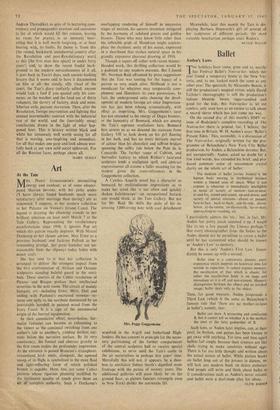Ballet
Auden's Laws THE holidays have come, gone and so, nearly, has Festival Ballet's Nutcracker, which this year found a temporary home at the New Vic- toria, and, to me, looked much the same as any other year. The spectacle, by Alexandre Benois, is still the production's magical virtue, while David Lichine's choreography is still the production's tedious blemish. Sweet, sugar-candied and good for the kids, this Nutcracker is, let me confess, only used here as an excuse to talk about a record sleeve which has just come my way.
On the second disc of this month's HMV re- issue of Rodzinski's complete recording of The Nutcracker there is printed, for, I believe, the first time in Britain. W. H. Auden's essay 'Ballet's Present Eden.' This, ostensibly, is a discussion of The Nutcracker, originally written for the pro- gramme of Balanchine's New York City Ballet production, by Auden, a Balanchine devotee. But, not unexpectedly, Auden, asked no doubt for a few kind words, has extended his brief, and pro- duced common sense of uncommon crystal clarity on the whole art of ballet: The medium of ballet [writes Auden]- is the human body moving in rhythmical balance within a limited area of space. What it can express is whatever is immediately intelligible in terms of variety of motion—fast-or-slow, to-and-fro, round-and-round, up-and-down; and variety of spatial relations--absent or present. face-to-face, back-to-back, side-by-side, above- below, at-the-centre, on-the-outside, far-or-near, approaching-or-receding, etc.
1 particularly admire the 'etc.,' but, in fact, Mr. Auden has pretty much summed it up. I would like to see a law passed (by Unesco perhaps?) that every choreographer from the Indies to the Andes should- not be permitted to create a ballet until he has committed what should be known as 'Auden's Law' to memory.
But this is only 'Auden's First Law.' Imme- diately he comes up with a second:
Ballet time is a continuous present; every experience which depends on historical time lies outside its capacities. It cannot express memory, the recollection of that which is absent, for either the recollection body is on stage and immediate or it is off and non-existent. Memory distinguishes between the object and its invoked image; ballet deals only in the object.
Then, for good measure, Auden propounds a Third Law (which is the same as Balanchine's famous rule that 'there arc no mother-in-laws in ballet'), namely, that :
Ballet can show A protecting and comforting B, but it cannot tell us whether A is the mother, the aunt or the fairy godmother of B.
Such laws, as Auden later implies, can, at their peril, be broken, and genius has been known to get away with anything. Yet time and time again ballets fail simply because their creators are like chefs trying to make omelettes without eggs. There is far too little thought and written about the actual nature of ballet. While picture books on ballet limp out of the presses in dozens, we still lack any modern book on dance aesthetics. And people still write and think about ballet 35 if considerations such as Auden's never existed, and ballet were a deaf-mute play for idiots.
CLIVE BARNES






























 Previous page
Previous page